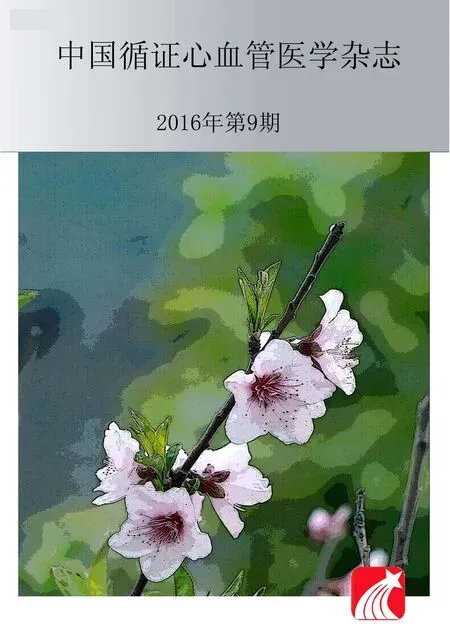人脐带间充质干细胞的研究进展及在心脏疾病中的应用
田洪榛,柏翠芳,陈光辉
· 综述 ·
人脐带间充质干细胞的研究进展及在心脏疾病中的应用
田洪榛1,2,柏翠芳3,陈光辉1
近年来人们饮食及生活方式发生了巨大变化,特别是人口老龄化的加速,我国面临心脏疾病发病率和死亡率快速增长的严峻形势。心肌细胞是不可再生细胞,常规药物治疗、血运重建、冠状动脉旁路移植等均不能使心肌细胞再生,寻找能够弥补心肌缺失的方法显得极为迫切。间充质干细胞(MSCs)具有自我更新、不断增殖、多向分化和免疫调节等能力,已成为再生医学的研究焦点。1970年,Friedenstein等首次在骨髓中发现并提取到骨髓间充质干细胞(BMMSCs)[1]。但从骨髓中提取BMMSCs的过程复杂,并对捐献者造成损伤。胚胎干细胞(ESCs)能分化成体内所有的细胞,是多能性干细胞的典型代表。近年研究发现诱导多能干细胞(iPSCs)具有与ESCs相似的多能性[2]。多能性是指这些细胞移植到免疫缺陷小鼠时可分化成三胚层(外胚层、中胚层及内胚层)的任意细胞的能力。但是胚胎干细胞的应用会产生严重的伦理问题。而iPSCs可能存在如c-myc的融合致癌基因、插入突变、抑癌基因破坏等情况[3],其临床应用受到批评与限制。寻找新的干细胞来源成为当务之急。
近期两项“吸血鬼疗法”的研究结果引人关注。研究者将幼鼠的血液移植注入年长小鼠体内,随后观察到年长小鼠的肌肉组织增加及神经功能的恢复,提示该效应与幼鼠血液中的干细胞密切相关,发现血液中生长分化因子11(GDF11)和环磷酸腺苷应答元件结合蛋白(CREB)与此效应相关[4,5]。人类干细胞主要来自羊水、脐带和胎盘,主要是间充质干细胞。因人脐带来源丰富,不对捐献者造成损伤,不产生伦理问题,成本较低,目前人脐带间充质干细胞(HUCMSCs)正被广泛研究。
1 HUCMSCs来源
人脐带在怀孕的第5周开始发育,并继续生长至50 cm左右。脐带由三部分构成:羊膜被覆上皮、脐血管和位于两者之间的黏液结缔组织—沃顿胶质。沃顿胶质对脐血管脐带有保护和支持作用。脐带的粗细和重量主要取决于沃顿胶质的数量。2003年,Mitchell等[6]首先在沃顿胶质提取分离出具有多项分化潜能的间充质干细胞,此后很多研究应用这种干细胞,并被称作脐带间充质干细胞。
2 HUCMSCs的一般生物学特性
2.1HUCMSCs的细胞形态和表面标志 组织块贴壁7 d后可见单个的梭形或多角形成纤维样细胞;传代后的细胞形态为相对均一的梭形,呈平行排列或旋涡状、鱼群状排列生长。透射电镜下观察多次传代后的细胞形态无明显改变,活性稳定。HUCMSCs体外培养传代超过80代而没有细胞形态的改变和细胞衰老迹象[6]。目前还没有发现HUCMSCs的特异分子标记,只能通过检测其免疫表型来间接鉴定。近年来的研究发现,HUCMSCs高表达MSCs标记(CD73、CD90、CD105)和黏附分子标记(CD54、CD13、CD29、CD44),低表达MHC-Ⅰ分子标记(HLA-ABC)等,不表达造血干细胞标记(CD31、CD34、CD45、CD117、CD14)、内皮细胞标记(CD33、CD133)及MHC-Ⅱ分子标记(HLA-DR、-DA、-DP、-DQ)等[7]。据报道HUCMSCs与ESCs的基因信息近似,HUCMSCs低表达一些转录因子如Oct-4、Sox-2、Nanog、KLF-4等,这些转录因子也多在ESCs表达[8]。
2.2HUCMSCs的免疫原性和免疫调节作用
2.2.1HUCMSCs具有极低的免疫原性 大量研究证实,HUCMSCs表达的 CD106、HLA-ABC 明显低于 BMMSCs,因此HUCMSCs较BMMSCs具有更低的免疫原性[9]。在脑损伤和退行性变的动物试验中进行细胞移植,发现机体并未针对移植细胞产生排斥反应[10]。近年来关于HUCMSCs的免疫特性进行了详细的研究,Troyer和Weiss得出的结论是在体内开放免疫环境中未见机体对HUCMSCs的免疫排斥,HUCMSCs在同种异基因移植的耐受性良好[11]。
2.2.2HUCMSCs的免疫调节作用 HUCMSCs可通过高表达白介素6(IL-6)和血管生长因子来抑制T细胞增殖[12],高表达具有抑制孕体胎儿排斥、介导异体皮和心脏移植免疫耐受效应的CD200[13]。还有研究表明HUCMSCs高表达人类白细胞抗原G(HLA-G)[14]或通过前列腺E2机制[15]抑制T细胞增殖,介导免疫耐受。HUCMSCs低水平表达ESCs的分子标记—OCT4,Nanog,Sox2和LIN28,从而能解释将其移植到免疫缺陷大鼠体内不产生畸胎瘤[16]。已证实在体外及小鼠体内HUCMSCs能抑制人乳腺癌细胞的生长,其抗癌作用可能通过细胞-细胞接触或分泌相关因子,使细胞凋亡相关基因及肿瘤抑制基因表达上调[17]。将HUCMSCs与树突状细胞共同培养发现,成熟树突状细胞表面标志CD80、CD83、CD86水平下降,HUCMSCs直接降低了树突状细胞的共刺激分子和抗原呈递能力,避免T细胞启动[18]。HUCMSCs能表达具有免疫调节功能的因子,如IDO-1、IL-10、LIF、PD-L1、COX-2、TGF-β1、TSG-6、CD200、HGF、HLA-E、HLA-G和HO-1,将HUCMSCs与T细胞共同培养,其通过接触依赖机制和IDO-1等可溶性分子抑制T细胞增殖,并可激活T细胞抑制TGF-γ的水平,诱导IL-10分泌[19]。这些研究表明HUCMSCs在体外对T淋巴细胞、树突状细胞具有负性调节作用。
3 HUCMSCs的多分化潜能
既往研究证实HUCMSCs在体外、体内均可分化为心肌细胞、内皮细胞、脂肪细胞、软骨细胞、成骨细胞、神经细胞、肝样细胞、胰岛细胞等[20,21]。
3.1HUCMSCs向心肌细胞分化的方法 已经证实向培养基中加入5氮胞苷(5-Aza)、二甲基亚砜(DMSO)、1-磷酸鞘氨醇(S1P)等诱导剂,能在体外诱导HUCMSCs定向分化为心肌样细胞。国外发现血管紧张素受体阻滞剂和匹格列酮等可促进HUCMSCs分化为心肌样细胞[22,23]。
3.2HUCMSCs诱导心肌样细胞机制 5-Aza处理HUCMSCs后,DLL4和Notch1基因的转录、表达水平升高(7 d时分别高达初始水平的7.8和11.4倍)[24],GATA4和Flk-1、Nkx2.5、Isl-1、Brachyury(T)等心脏发育过程中关键的转录因子表达增高,肌钙蛋白I(cTnI)表达水平增高[25]。提示DLL4-Notch信号通路在HUCMSCs向心肌样细胞的分化过程中有重要作用。还有研究发现经5-Aza处理后,HUCMSCs的ERK磷酸化水平和MEF-2蛋白表达升高,进而引发STAT3磷酸化以及MEF-2C和MyoD基因表达的上调,进一步激活心肌特异基因包括desmin、β-MHC、NKx2.5、cTnT、ANP 的转录,使HUCMSCs向心肌样细胞分化[26]。
研究证实转录因子Nkx2.5促进HUCMSCs分化为心肌样细胞,并使心肌样细胞的cTnI、Desmin、Nkx2.5和GATA-4表达增加[27]。缺氧预处理能增强HUCMSC的增殖和向心肌样细胞分化的能力,增加HUCMSCs和分化心肌样细胞的抗缺氧能力,提高其在治疗心肌梗死及心力衰竭的存活率[28]。急性心肌梗死大鼠模型的试验提示,在急性心肌梗死后梗死相关的生物和物理因子通过TGF-β/ BMP-2途径诱导HUCMSCs向心肌样细胞分化[29]。干细胞的分化涉及多个基因的转录表达,多条信号通路及相互作用,最终才能分化为特定的终末分化细胞。目前仍需进一步研究来了解干细胞的分化机制。
4 HUCMSC在心脏疾病的临床应用
Sun L等[30]将HUCMSCs经静脉输注到兔、豚鼠和大鼠后,未观察到肝脏、肾脏功能损害,无溶血及全身过敏反应,热原及血液学指标未见异常,提示HUCMSCs的免疫耐性良好,经静脉途径应用安全。许多急性心肌梗死的动物模型试验提示移植HUCMSCs后,能通过保护心肌细胞免于凋亡、促进血管生成、减少心肌纤维化等作用,提高左室射血分数、缩小心肌梗死面积、改善心脏收缩功能[31,32]。
Xia等[33]对15例高龄冠心病合并冠状动脉慢性闭塞的患者进行了HUCMSCs经冠状动脉移植,随访2年期间未发生心血管不良事件、心律失常等,患者的左室收缩功能显著改善,心肌缺血及梗死面积缩小,这些效应与HUCMSCs对血管紧张素、醛固酮及炎症因子的作用相关。Gao等[34]开展了关于HUCMSCs一项随机双盲对照研究,将116例急性ST段抬高的心肌梗死患者随机分成治疗组和安慰剂组,在成功血运重建后,治疗组经冠状动脉注入了干细胞混悬液,随访18个月发现治疗组的心肌活力增加、梗死面积缩小,左室射血分数明显升高,左室舒张末期容积和左室收缩末期容积明显减小,提示经冠状动脉移植HUCMSCs治疗急性心肌梗死是一种安全有效的方法。Samuel Golpanian等[35]对TESI和TAC-HFT两项随机研究进行亚组分析显示:心内膜下注射间充质干细胞治疗缺血性心肌病在年龄大于60岁或小于60岁的患者均安全有效,年龄不影响干细胞的治疗效果。Mushtaq M等[36]正在进行POSEIDON-DCM的随机对照研究,这是一个关于自体骨髓间充质干细胞和异体骨髓间充质干细胞对扩张型心肌病的治疗效果与安全性的研究,期待试验结果的公布。
综上,HUCMSCs具有极低的免疫原性、良好的多分化潜能和免疫调节、抗癌效应,其来源丰富,成本低,对供体无损伤,不涉及伦理问题,是再生医学研究的重要成员。目前已尝试在包括心肌梗死、心力衰竭、心肌病、白血病、糖尿病、多发性硬化等多系统多种疾病应用,但治疗机制还不十分清楚,其治疗的安全性及长期疗效更需大样本、多中心的随机前瞻性试验进行验证。
[1] Friedenstein AJ,Chailakhjan RK,Lalykina KS. The development of fibroblast colonies in monolayer cultures of guinea-pig bone marrow and spleen cells[J]. Cell Tissue Kinet,1970,3(4):393-403.
[2] Yamanaka S,Takahashi K. Induction of pluripotent stem cells from mouse embryonic and adult fibroblast cultures by defined factors[J]. Cell,2006,126(4):663-76.
[3] Cavazzana-Calvo M,Payen E,Negre O,et al. Transfusion independence and HMGA2 activation after gene therapy of human betathalassaemia[J]. Nature,2010,467(7313):318-22.
[4] Sinha M,Jang YC,Oh J,et al. Restoring systemic GDF11 levels reverses age-related dysfunction in mouse skeletal muscle[J]. Science, 2014,344(6184):649-52.
[5] Villeda SA,Plambeck KE,Middeldorp J,et al. Young blood reverses age-related impairments in cognitive function and synaptic plasticity in mice[J]. Nat Med,2014,20(6):659-63.
[6] Mitchell K,Weiss ML,Mitchell JB,et al. Matrix cells from Wharton's jelly from neurons and glia[J]. Stem Cells,2003,21(1):50-60.
[7] Ishige I,Nagamura-Inoue T,Honda MJ,et al. Comparison of mesenchymal stem cells derived from arterial, venous, and Wharton’s jelly explants of human umbilical cord[J]. Int J Hematol,2009,90(2):261-9.
[8] Greco SJ,Liu K,Rameshwar P. Functional similarities among genes regulated by OCT4 in human mesenchymal and embryonic stem cells[J]. Stem Cells,2007,25(12):3143-54.
[9] Lu LL,Liu YJ,Yang SG,et al. Isolation and characterization of human umbilical cord mesenchymal stem cells with hematopoiesissupportive function and other potentials[J]. Haematologica,2006,91(8):1017-26.
[10] Liao W,Xie J,Zhong J,et al. Therapeutic effect of human umbilical cord multipotent mesenchymal stromal cells in a rat model of stroke[J]. Transplantation,2009,87(3):350-9.
[11] La Rocca G,Anzalone R,Farina F. The expression of CD68 in human umbilical cord mesenchymal stem cells: new evidences of presence in non-myeloid cell types[J]. Scand J Immunol,2009,70(2):161-2.
[12] Troyer DL,Weiss ML. Wharton's jelly-derived cells are a primitive stromal cell population[J]. Stem Cells,2008,26(3):591-9.
[13] Djouad F,Charbonnier LM,Bouffi C,et al. Mesenchymal stem cells inhibit the differentiation of dendritic cells through an interleukin-6-dependent mechanism[J]. Stem Cells,2007,25(8):2025-32.
[14] Fong CY,Chak LL,Biswas A,et al. Human Wharton's jelly stem cells have unique transcriptome profiles compared to human embryonic stem cells and other mesenchymal stem cells[J]. Stem Cell Rev,2011,7(1):1-16.
[15] Le Blanc K. Immunomodulatory effects of fetal and adult mesenchymalstem cells[J]. Cytotherapy,2003,5(6):485-9.
[16] Chen K,Wang D,Du WT,et al. Human umbilical cord mesenchymalstem cells hUC-MSCs exert immunosuppressive activities through a PGE2-dependent mechanism[J]. Clin Immunol,2010,135(3):448-58.
[17] Fong CY,Richards M,Manasi N,et al. Comparative growth behaviour and characterization of stem cells from human Wharton's jelly[J]. Reprod Biomed,2007,15(6):708-18.
[18] Witkowska-Zimny M,Wrobel E. Perinatal sources of mesenchymal stem cells: Wharton's jelly, amnion and chorion[J]. Cell Mol Biol Lett,2011,16(3):493-514.
[19] Donders R,Vanheusden M,Bogie JF,et al. Human Wharton’s Jelly-Derived Stem Cells Display Immunomodulatory Properties and Transiently Improve Rat Experimental Autoimmune Encephalomyelitis[J]. Cell Transplant,2015,24(10):2077-98.
[20] Anzalone R,Iacono ML,Corrao S,et al. New emerging potentials for human Wharton’s jelly mesenchymal stem cells: immunological features and hepatocyte-like differentiative capacity[J]. Stem Cells Dev,2010,19(4):423-38.
[21] Anzalone R,Lo Iacono M,Loria T,et al. Wharton’s Jelly mesenchymal stem cells as candidates for beta cells regeneration: extending the differentiative and immunomodulatory benefits of adult mesenchymal stem cells for the treatment of type 1 diabetes[J]. Stem Cell Rev,2011,7(2):342-63.
[22] Shinmura D,Togashi I,Miyoshi S,et al. Pretreatment of human mesenchymal stem cells with pioglitazone improved efficiency of cardiomyogenictransdifferentiation and cardiac function[J]. Stem Cells,2011,29(2):357-66.
[23] Numasawa Y,Kimura T,Miyoshi S,et al. Treatment of human mesenchymal stem cells with angiotensin receptor blocker improved efficiency of cardiomyogenictransdifferentiation and improved cardiac function via angiogenesis[J]. Stem Cells,2011,29(9):1405-14.
[24] Zhu L,Ruan Z,Yin Y,et al. Expression and significance of DLL4--Notch signaling pathway in the differentiation of human umbilical cord derived mesenchymal stem cells into cardiomyocytes induced by 5-azacytidine[J]. Cell BiochemBiophys,2015,71(1):249-53.
[25] Gao LR,Zhang NK,Ding QA,et al. Common expression of stemness molecular markers and early cardiac transcription factors in Wharton’s jelly-derived mesenchymal stem cells and hESCs[J]. Cell Transplant,2013,22(10):1883-900.
[26] Qian Qian,Hui Qian,Xu Zhang,et al. 5-Azacytidine Induces Cardiac differentiation of human umbilical cord-derived mesenchymal stem cells by activating extracellular regulated kinase[J]. Stem Cells Dev,2012,21(1):67-75.
[27] Ruan Z,Zhu L,Yin Y,et al. Overexpressing NKx2.5 increases the differentiation of human umbilical cord drived mesenchymal stem cells into cardiomyocyte-like cells[J]. Biomed Pharmacother,2016,78:110-5.
[28] Zhang L,Yang J,Tian YM,et al. Beneficial Effects of Hypoxic Preconditioning on Human Umbilical Cord Mesenchymal Stem Cells[J]. Clin J Physiol,2015,58(5):343-53.
[29] Chang SA,Lee EJ,Kang HJ,et al. Impact of Myocardial Infarct Proteins and Oscillating Pressure on the Differentiation of Mesenchymal Stem Cells: Effect of Acute Myocardial Infarction on Stem Cell Differentiation[J]. Stem Cells,2008,26(7):1901-12.
[30] Sun L,Xu R,Sun X,et al. Safety evaluation of exosomes derived from human umbilical cord mesenchymal stromal cell[J]. Cytotherapy,2016,18(3):413-22.
[31] Zhao Y,Sun X,Cao W,et al. Exosomes Derived from Human Umbilical Cord Mesenchymal Stem Cells Relieve Acute Myocardial Ischemic Injury[J]. Stem Cells Int,2015,2015:761643.
[32] Latifpour M,Nematollahi-Mahani SN,Deilamy M,et al. Improvement in cardiac function following transplantation of human umbilical cord matrix-derived mesenchymal cells[J]. Cardiology,2011,120(1):9-18.
[33] Xia Li,You-dong Hu,Ying Chen,et al. Mechanisms of Improvement of Left Ventricular Function by Intracoronary Human Umbilical Cord-Derived Mesenchymal Stem Cell Infusion in Very Old Patients with Coronary Chronic Total Occlusion[J]. Current Pharmaceutical Design,2015,21(26):3844-50.
[34] Gao LR,Chen Y,Zhang NK,et al. Intracoronary infusion of Wharton’s jelly-derived mesenchymal stem cells in acute myocardial infarction: double-blind, randomized controlled trial[J]. BMC Med,2015,13:162.
[35] Samuel Golpanian,Jill El-Khorazaty,Adam Mendizabal,et al. Effect of Aging on Human Mesenchymal Stem Cell Therapy in Ischemic Cardiomyopathy Patients[J]. J Am Coll Cardiol,2015,65(2):125-32.
[36] Mushtaq M,DiFede DL,Golpanian S. Rationale and design of the Percutaneous Stem Cell Injection Delivery Effects on Neomyogenesis in Dilated Cardiomyopathy (the POSEIDON-DCM study): a phase I/II, randomized pilot study of the comparative safety and efficacy of transendocardial injection of autologous mesenchymal stem cell vs. allogeneic mesenchymal stem cells in patients with non-ischemic dilated cardiomyopathy[J]. J CardiovascTransl Res,2014,7(9):769-80.
本文编辑:姚雪莉
欢迎投稿,欢迎订阅!
中国科技核心期刊,科技论文统计源期刊E-mail:ebcvm_cj@126.com;
网址:www.ebcvm.com/www.ebcvm.org
R541
A
1674-4055(2016)09-1144-03
1100853 北京,解放军总医院心血管内科;2010051 呼和浩特,解放军第253医院心肾内科;3100853 北京,解放军总医院心脏介入中心
陈光辉,E-mail:13910669498@163.com
10.3969/j.issn.1674-4055.2016.09.42

